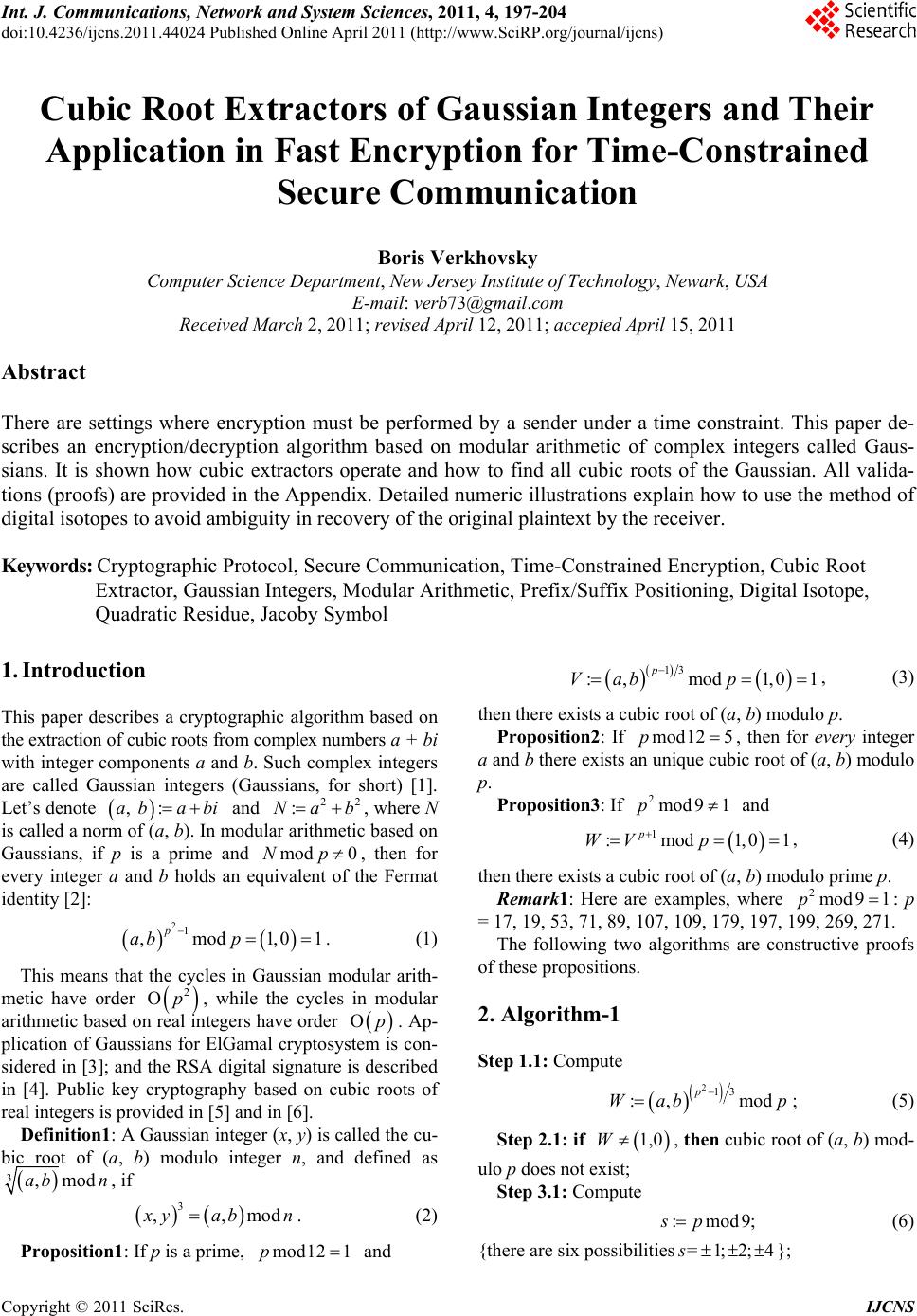 Int. J. Communications, Network and System Sciences, 2011, 4, 197-204 doi:10.4236/ijcns.2011.44024 Published Online April 2011 (http://www.SciRP.org/journal/ijcns) Copyright © 2011 SciRes. IJCNS Cubic Root Extractors of Gaussian Integers and Their Application in Fast Encryption for Time-Constrained Secure Communication Boris Verkhovsky Computer Science Department, New Jersey Institute of Technology, Newark, USA E-mail: verb73@gmail.com Received March 2, 2011; revised April 12, 2011; accepted April 15, 2011 Abstract There are settings where encryption must be performed by a sender under a time constraint. This paper de- scribes an encryption/decryption algorithm based on modular arithmetic of complex integers called Gaus- sians. It is shown how cubic extractors operate and how to find all cubic roots of the Gaussian. All valida- tions (proofs) are provided in the Appendix. Detailed numeric illustrations explain how to use the method of digital isotopes to avoid ambiguity in recovery of the original plaintext by the receiver. Keywords: Cryptographic Protocol, Secure Communication, Time-Constrained Encryption, Cubic Root Extractor, Gaussian Integers, Modular Arithmetic, Prefix/Suffix Positioning, Digital Isotope, Quadratic Residue, Jacoby Symbol 1. Introduction This paper describes a cryptographic algorithm based on the extraction of cubic roots from complex numbers a + bi with integer components a and b. Such complex integers are called Gaussian integers (Gaussians, for short) [1]. Let’s denote and , where N is called a norm of (a, b). In modular arithmetic based on Gaussians, if p is a prime and , then for every integer a and b holds an equivalent of the Fermat identity [2]: , :aba bi 2 :Nab mod 0Np 2 1 21 ,mod1,0 p ab p . (1) This means that the cycles in Gaussian modular arith- metic have order , while the cycles in modular arithmetic based on real integers have order 2 p p. Ap- plication of Gaussians for ElGamal cryptosystem is con- sidered in [3]; and the RSA digital signature is described in [4]. Public key cryptography based on cubic roots of real integers is provided in [5] and in [6]. Definition1: A Gaussian integer (x, y) is called the cu- bic root of (a, b) modulo integer n, and defined as 3,modab n, if 3 ,,mod yabn. (2) Proposition1: If p is a prime, and mod12 1p 13 :,mod 1,0 p Vab p 1 , (3) then there exists a cubic root of (a, b) modulo p. Proposition2: If , then for every integer a and b there exists an unique cubic root of (a, b) modulo p. mod12 5p Proposition3: If and 2mod 91p 1 :mod1,0 p WV p 1 , (4) then there exists a cubic root of (a, b) modulo prime p. Remark1: Here are examples, where 2mod 91p : p = 17, 19, 53, 71, 89, 107, 109, 179, 197, 199, 269, 271. The following two algorithms are constructive proofs of these propositions. 2. Algorithm-1 Step 1.1: Compute 213 :, mod p Wab p ; (5) Step 2.1: if 1,0W, then cubic root of (a, b) mod- ulo p does not exist; Step 3.1: Compute :mod9sp ; (6) {there are six possibilities}; = 1;2;4s 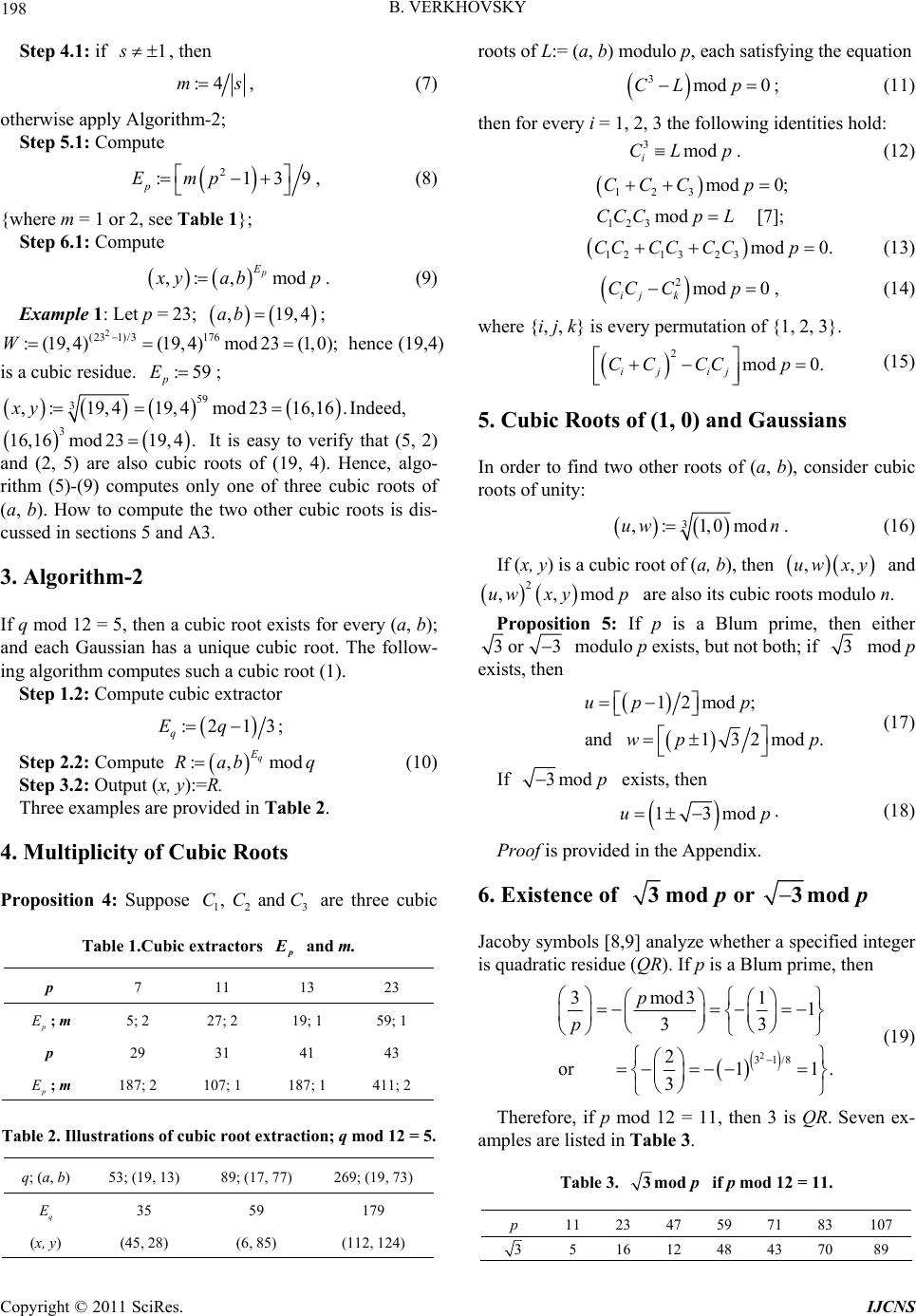 198 B. VERKHOVSKY Step 4.1: if , then 1s :4ms, (7) otherwise apply Algorithm-2; Step 5.1: Compute 2 :13 p Emp 9 , (8) {where m = 1 or 2, see Table 1}; Step 6.1: Compute ,: ,mod p E yabp 4 . (9) Example 1: Let p = 23; ; ,19,ab 176 2 (23 1)/3 :(19, 4)(19, 4)mod 23(1,0);W :59 p E hence (19,4) is a cubic residue. ; 59 3 ,:19,419,4mod 2316,16.xy Indeed, 3 16,16mod 2319, 4. It is easy to verify that (5, 2) and (2, 5) are also cubic roots of (19, 4). Hence, algo- rithm (5)-(9) computes only one of three cubic roots of (a, b). How to compute the two other cubic roots is dis- cussed in sections 5 and A3. 3. Algorithm-2 If q mod 12 = 5, then a cubic root exists for every (a, b); and each Gaussian has a unique cubic root. The follow- ing algorithm computes such a cubic root (1). Step 1.2: Compute cubic extractor :2 13 q Eq ; Step 2.2: Compute (10) :, mod q E Rab q Step 3.2: Output (x, y):=R. Three examples are provided in Table 2. 4. Multiplicity of Cubic Roots Proposition 4: Suppose are three cubic 12 , and CC C 3 Table 1.Cubic extractors and m. p 7 11 13 23 p E; m 5; 2 27; 2 19; 1 59; 1 p 29 31 41 43 p E; m 187; 2 107; 1 187; 1 411; 2 Table 2. Illustrations of cubic root extraction; q mod 12 = 5. q; (a, b) 53; (19, 13) 89; (17, 77) 269; (19, 73) q E 35 59 179 (x, y) (45, 28) (6, 85) (112, 124) roots of L:= (a, b) modulo p, each satisfying the equation 3mod 0CL p ; (11) then for every i = 1, 2, 3 the following identities hold: 3mod i CL p. (12) 123 123 mod0; mod [7]; CCC p CC CpL 12 1323mod 0.CCCC CCp (13) 2mod 0 ij k CC Cp , (14) where {i, j, k} is every permutation of {1, 2, 3}. 2mod 0. ij ij CC CCp (15) 5. Cubic Roots of (1, 0) and Gaussians In order to find two other roots of (a, b), consider cubic roots of unity: 3 ,: 1,0moduw n. (16) If (x, y) is a cubic root of (a, b), then ,,uwxy and 2 ,,moduw xyp are also its cubic roots modulo n. Proposition 5: If p is a Blum prime, then either 3or3 modulo p exists, but not both; if 3 mod p exists, then 12mod; and 132mod. up p wp p (17) If 3modp exists, then 13modu p . (18) Proof is provided in the Appendix. 6. Existence of 3 modor3modpp Jacoby symbols [8,9] analyze whether a specified integer is quadratic residue (QR). If p is a Blum prime, then 2 31/8 3mod31 1 33 2 or 11. 3 p p (19) Therefore, if p mod 12 = 11, then 3 is QR. Seven ex- amples are listed in Table 3. Table 3. 3mod if p mod 12 = 11. p 11 23 47 59 71 83 107 3 5 16 12 48 43 70 89 Copyright © 2011 SciRes. IJCNS  B. VERKHOVSKY 199 ,; mod; p Yet, if p mod 12 = 7, then –3 is QR. (20) 7. Properties of Gaussian Cubes Consider 322 22 ,:,3, 3modtvuwu uwwuwp (21) Property 1: 322 22 ,3,3uwuuwwu wtv (22) Property 2: 322 22 ,3,3(,)wuw wuuwuvtp (23) Property 3: If u + w = p, then 33 3 ,, mo1d1,uuwwu . (24) 8. Cryptographic Protocol System design (each user’s actions): Step 1.3: Selects two large distinct primes p and q, where p mod 12 = 11; ; and q mod 12 = 5; 2mod 91p Step 2.3: Computes n = pq; {n is user’s public key; p and q are his private keys}; Step 3.3: Finds cubic root (u, w) of (1, 0) modulo p: 12mod;3mod.uppwu p Step 4.3: Pre-computes 11 :mod; :modmod;PqqpQ ppqn Protocol implementation: Suppose a sender (Sam) wants to securely transmit a plaintext G to receiver (Re- gina); Sam divides G into an array of blocks 112 2 ,; ,;; , ; kk ghghgh and kk in such a way that every nhn; Encryption {Sam’s actions}: Step 5.3: He gets Regina’s public key n; computes ciphertext 3 ,:, modab ghn; and sends (a, b) to her; Decryption {Regina’s actions}: Step 6.3: She, using her private keys p and q, extracts cubic roots 33 1:,mod; and :,mod; abpR abq Step 7.3: She computes 21 32 :,mod ; and :,mod ; Muw pMMuw p Step 8.3: {Using Chinese Remainder Theorem [10], Re- gina computes all 3 roots of (a, b) 3 :,modDabn }: for k = 1,2,3 :m kk DMPRQodn; Step 9.3: {The original plaintext is recovered via dig- ital isotopes-see sections 10 and 11}: D = G. 9. Efficient Encryption of Gaussians Squaring of a Gaussian requires two multiplications of real integers (MoRI); and multiplication of two Gaus- sians requires three MoRI [11]. Therefore, the cubic power of Gaussian requires five MoRI. Yet, encryption 33223 ,:,3 ,3modabghgghgh hp in Step 5.3 requires only four MoRI: 22 12 12 32 41 33 44 :mod;:mod; :;:2;:2 :mod;:mod; PgpPh p SPP AS P A S P PgA pPhAp ; {there are no 1 and 2 }; where the doublings are achieved by binary shifting; then 1 2 and P 2 2P 34 ,P P,:ab. 10. Asymmetric Tagging of Digital Isotopes In cryptographic algorithms based on extraction of square roots of real integers [12] or Gaussians [6] there are four pairs of solutions, and only one of them is the original plaintext. To distinguish the original solution from the other three, the authors use methods of tails, which is an analogue of using isotopes to tag various chemical com- ponents. If the digital isotopes repeat r rightmost digits in each component of plaintext (g, h), then the probability of erroneous recovery of the “plaintext” is of order 2 110r . For instance, if the length of isotope r = 3, then the probability of error is one in one million. As shown below, a more elaborate strategy must be used to avoid ambiguity in the recovery of the original plaintext. Definition 2: If there exist Gaussians with distinct components x and y such that 33 ,,mod yyx p, (25) then such cubic roots are called Gaussian twins (or CT, for short). Proposition 6: If the square root of 3 modulo prime p exists, then there exists the CT; {see Table4 for examples}. Table 4. Examples of cubic roots twins (CT) for p = 83. (a, b) (27, 56) (31, 52)(26, 57) (2, 81) (78, 5)(53, 30) 3,ab (22, 76); (76, 22) (15, 24); (24, 15) (46, 8); (8, 46) (77, 7); (7, 77) (8, 5); (5, 8) (1, 11); (11, 1) Copyright © 2011 SciRes. IJCNS 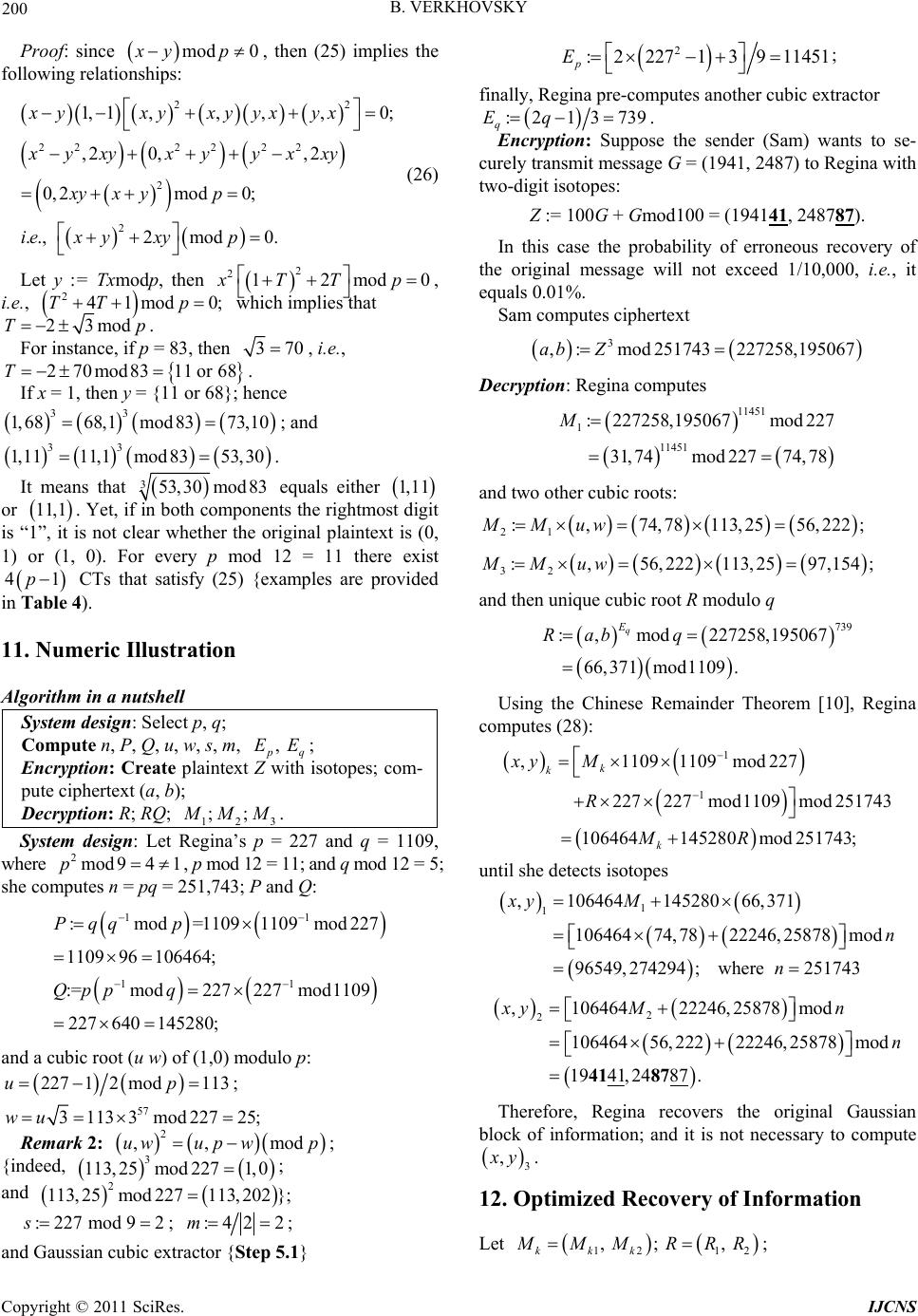 B. VERKHOVSKY 200 0 Proof: since , then (25) implies the following relationships: mod 0xy p 22 2222 22 2 2 1, 1,,,,0; ,2 0,,2 0, 2mod0; .., 2mod0. x yxyxy yxyx xy xyxyy x xy xyxyp iex yxyp (26) Let y := Txmod p, then i.e., which implies that 2 212modxTTp , 0; 241modTT p 23modTp . For instance, if p = 83, then 370, i.e., . 270mod8311 or 68T If x = 1, then y = {11 or 68}; hence ; and . 33 1,6868,1 mod8373,10 33 1,1111,1mod 8353,30 It means that 353,30mod83 equals either 1,11 or . Yet, if in both components the rightmost digit is “1”, it is not clear whether the original plaintext is (0, 1) or (1, 0). For every p mod 12 = 11 there exist CTs that satisfy (25) {examples are provided in Table 4). 11,1 41p 11. Numeric Illustration Algorithm in a nutshell System design: Let Regina’s p = 227 and q = 1109, where , p mod 12 = 11; and q mod 12 = 5; she computes n = pq = 251,743; P and Q: 2mod 941p 11 11 :mod=11091109mod 227 1109 96106464; :=mod227227mod1109 227 640145280; Pqq p Qpp q and a cubic root (u w) of (1,0) modulo p: 22712 mod113up ; 57 31133mod 22725;wu Remark 2: ; 2 ,,moduwup wp 3 , 25mod 2271, 0 {indeed, ; 113 2 and 113,25mod 227113,202}; :227 mod 9 2s; :42 2m; and Gaussian cubic extractor {Step 5. 1} 2 : 2 2271 3911451 p E ; finally, Regina pre-computes another cubic extractor :2 13739 q Eq . Encryption: Suppose the sender (Sam) wants to se- curely transmit message G = (1941, 2487) to Regina with two-digit isotopes: Z := 100G + Gmod100 = (194141, 248787). In this case the probability of erroneous recovery of the original message will not exceed 1/10,000, i.e., it equals 0.01%. Sam computes ciphertext 3 ,:mod 251743227258,195067ab Z Decryption: Regina computes 11451 1 11451 :227258,195067mod 227 31,74mod22774,78 M and two other cubic roots: 21 :,74,78113,2556, 222;MMuw 32 :,56,222113,2597,154;MMuw and then unique cubic root R modulo q 739 : ,mod227258,195067 66,371mod1109. q E Rab q Using the Chinese Remainder Theorem [10], Regina computes (28): System design: Select p, q; Compute n, P, Q, u, w, s, m, , q Encryption: Create plaintext Z with isotopes; com- pute ciphertext (a, b); EE; Decryption: R; RQ; 12 ;; 1 1 ,11091109mod 227 227227mod1109mod251743 106464145280mod251743; k k k xy M R MR 3 MM. until she detects isotopes 1 1 ,106464145280 66,371 10646474,7822246, 25878mod 96549,274294;where251743 xy M n n 2 2 ,10646422246,25878mod 10646456,22222246, 25878mod 1941, 2487. xy Mn n 41 87 Therefore, Regina recovers the original Gaussian block of information; and it is not necessary to compute 3 , y. 12. Optimized Recovery of Information Let 12 12 , ; , kkk MM RRR; Copyright © 2011 SciRes. IJCNS 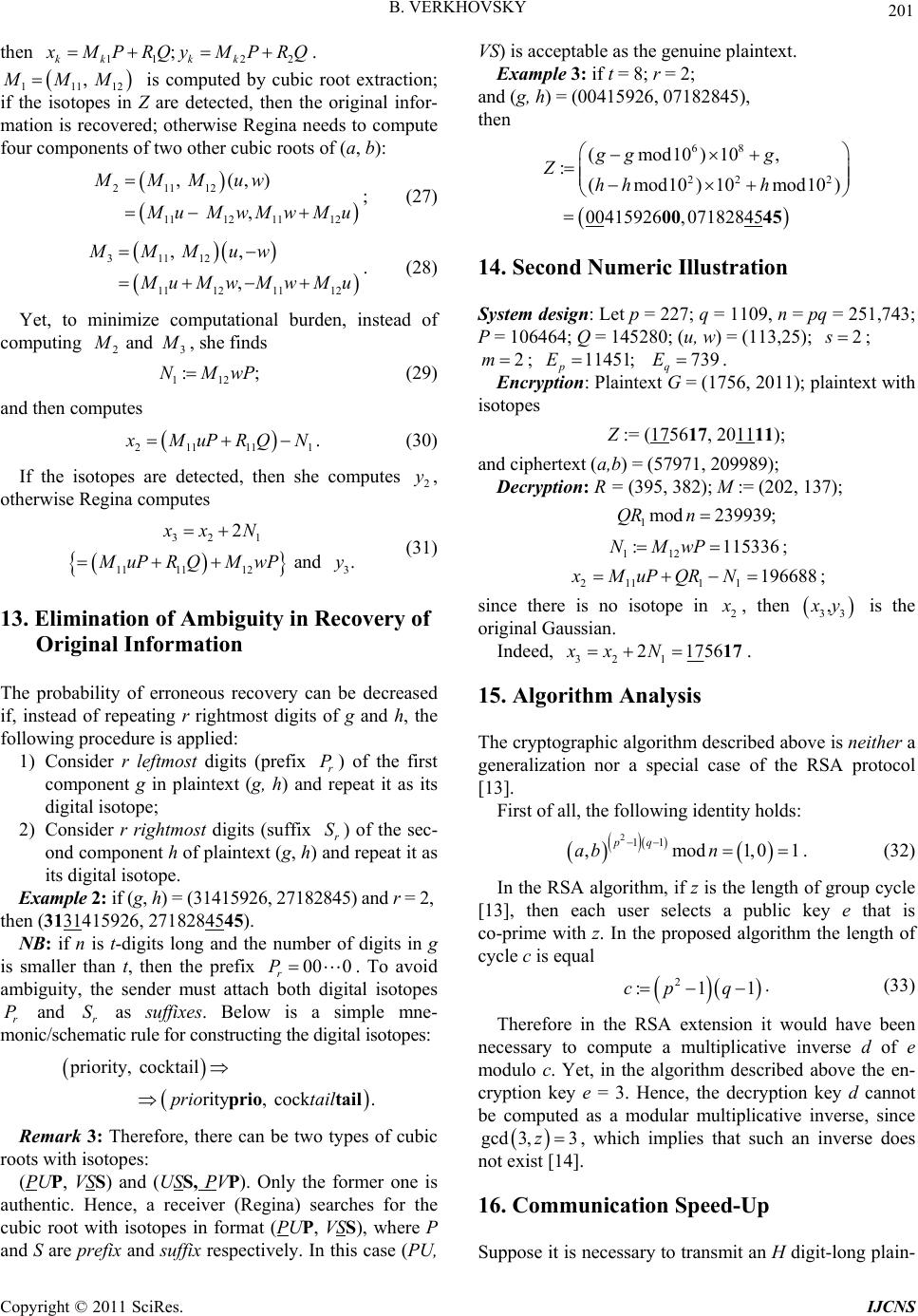 B. VERKHOVSKY 201 then 112 2 ; kk kk MP RQyMP RQ . 11112 , MMM is computed by cubic root extraction; if the isotopes in Z are detected, then the original infor- mation is recovered; otherwise Regina needs to compute four components of two other cubic roots of (a, b): 21112 1112 1112 , (,) , MMMuw uMwMwMu ; (27) 31112 11 121112 , , , MMMuw uMwMwMu . (28) Yet, to minimize computational burden, instead of computing 2 and 3 M, she finds 112 :NMwP; (29) and then computes 211111 MuP RQN. (30) If the isotopes are detected, then she computes , otherwise Regina computes 2 y 32 1 11 11123 2 and . xx N uPRQMwPy (31) 13. Elimination of Ambiguity in Recovery of Original Information The probability of erroneous recovery can be decreased if, instead of repeating r rightmost digits of g and h, the following procedure is applied: 1) Consider r leftmost digits (prefix r P) of the first component g in plaintext (g, h) and repeat it as its digital isotope; 2) Consider r rightmost digits (suffix r S) of the sec- ond component h of plaintext (g, h) and repeat it as its digital isotope. Example 2: if (g, h) = (31415926, 27182845) and r = 2, then (3131415926, 2718284545). NB: if n is t-digits long and the number of digits in g is smaller than t, then the prefix . To avoid ambiguity, the sender must attach both digital isotopes r and r as suffixes. Below is a simple mne- monic/schematic rule for constructing the digital isotopes: 00 0 r P P S priority, cocktail rity, cock.prio tail prio tail Remark 3: Therefore, there can be two types of cubic roots with isotopes: (PUP, VSS) and (USS, PVP). Only the former one is authentic. Hence, a receiver (Regina) searches for the cubic root with isotopes in format (PUP, VSS), where P and S are prefix and suffix respectively. In this case (PU, VS) is acceptable as the genuine plaintext. Example 3: if t = 8; r = 2; and (g, h) = (00415926, 07182845), then 68 22 2 (mod10 )10, : (mod10 )10mod10 ) 00415926,07182845 gg g Z hh h 00 45 14. Second Numeric Illustration System design: Let p = 227; q = 1109, n = pq = 251,743; P = 106464; Q = 145280; (u, w) = (113,25); 2s ; 2m ; 11451; p E 739 q E . Encryption: Plaintext G = (1756, 2011); plaintext with isotopes Z := (175617, 201111); and ciphertext (a,b) = (57971, 209989); Decryption: R = (395, 382); M := (202, 137); 1mod239939;QRn 112 : 115336NMwP 196xM uPQRN ; 21111688 ; since there is no isotope in 2 , then 33 , y is the original Gaussian. Indeed, 321 21756xx N 17 . 15. Algorithm Analysis The cryptographic algorithm described above is neither a generalization nor a special case of the RSA protocol [13]. First of all, the following identity holds: 211 ,mod1,0 pq ab n 1. (32) In the RSA algorithm, if z is the length of group cycle [13], then each user selects a public key e that is co-prime with z. In the proposed algorithm the length of cycle c is equal 2 :1cp q 1 . (33) Therefore in the RSA extension it would have been necessary to compute a multiplicative inverse d of e modulo c. Yet, in the algorithm described above the en- cryption key e = 3. Hence, the decryption key d cannot be computed as a modular multiplicative inverse, since gcd 3,3z , which implies that such an inverse does not exist [14]. 16. Communication Speed-Up Suppose it is necessary to transmit an H digit-long plain- Copyright © 2011 SciRes. IJCNS 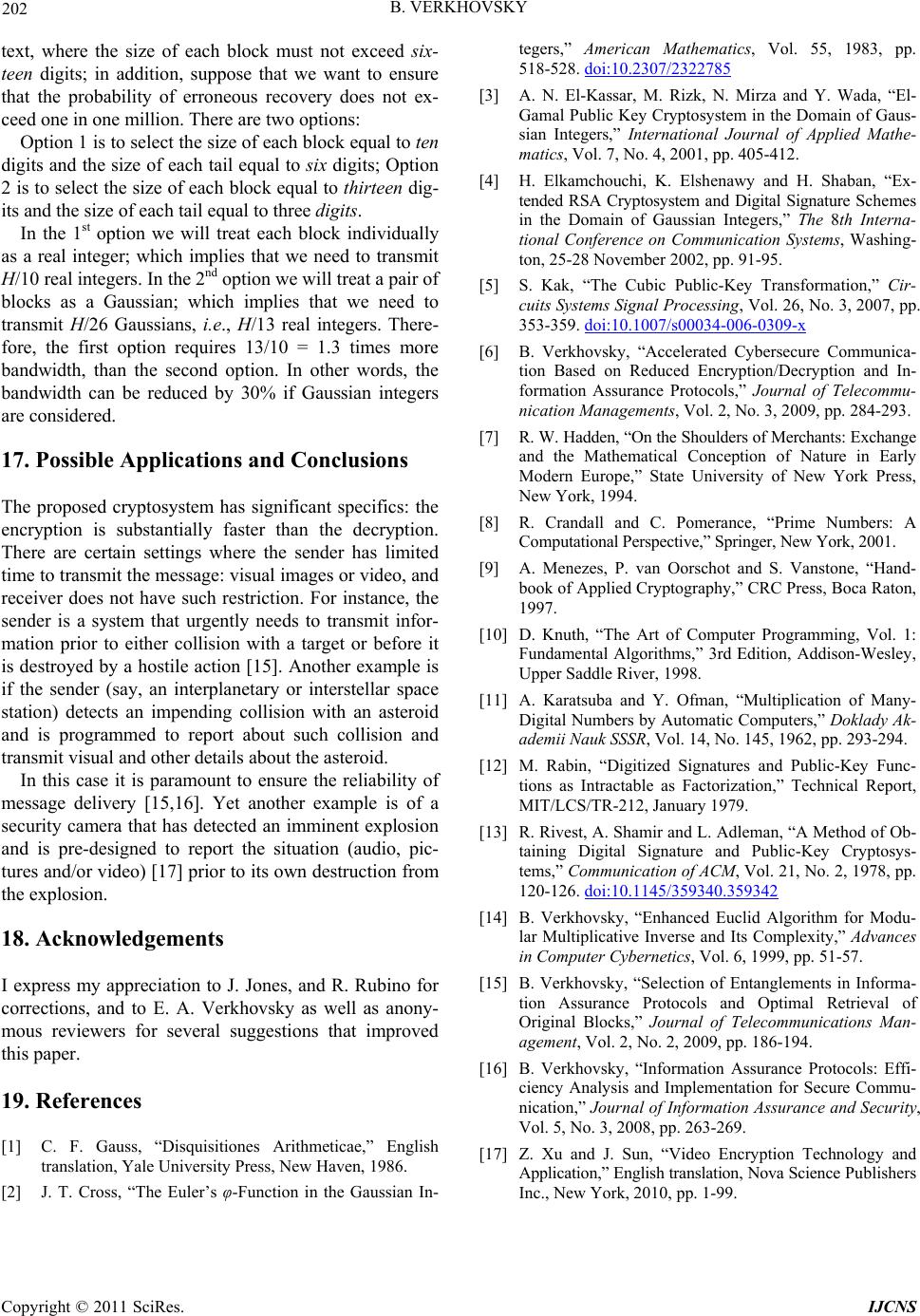 B. VERKHOVSKY Copyright © 2011 SciRes. IJCNS 202 text, where the size of each block must not exceed six- teen digits; in addition, suppose that we want to ensure that the probability of erroneous recovery does not ex- ceed one in one million. There are two options: Option 1 is to select the size of each block equal to ten digits and the size of each tail equal to six digits; Option 2 is to select the size of each block equal to thirteen dig- its and the size of each tail equal to three digits. In the 1st option we will treat each block individually as a real integer; which implies that we need to transmit H/10 real integers. In the 2nd option we will treat a pair of blocks as a Gaussian; which implies that we need to transmit H/26 Gaussians, i.e., H/13 real integers. There- fore, the first option requires 13/10 = 1.3 times more bandwidth, than the second option. In other words, the bandwidth can be reduced by 30% if Gaussian integers are considered. 17. Possible Applications and Conclusions The proposed cryptosystem has significant specifics: the encryption is substantially faster than the decryption. There are certain settings where the sender has limited time to transmit the message: visual images or video, and receiver does not have such restriction. For instance, the sender is a system that urgently needs to transmit infor- mation prior to either collision with a target or before it is destroyed by a hostile action [15]. Another example is if the sender (say, an interplanetary or interstellar space station) detects an impending collision with an asteroid and is programmed to report about such collision and transmit visual and other details about the asteroid. In this case it is paramount to ensure the reliability of message delivery [15,16]. Yet another example is of a security camera that has detected an imminent explosion and is pre-designed to report the situation (audio, pic- tures and/or video) [17] prior to its own destruction from the explosion. 18. Acknowledgements I express my appreciation to J. Jones, and R. Rubino for corrections, and to E. A. Verkhovsky as well as anony- mous reviewers for several suggestions that improved this paper. 19. References [1] C. F. Gauss, “Disquisitiones Arithmeticae,” English translation, Yale University Press, New Haven, 1986. [2] J. T. Cross, “The Euler’s φ-Function in the Gaussian In- tegers,” American Mathematics, Vol. 55, 1983, pp. 518-528. doi:10.2307/2322785 [3] A. N. El-Kassar, M. Rizk, N. Mirza and Y. Wada, “El- Gamal Public Key Cryptosystem in the Domain of Gaus- sian Integers,” International Journal of Applied Mathe- matics, Vol. 7, No. 4, 2001, pp. 405-412. [4] H. Elkamchouchi, K. Elshenawy and H. Shaban, “Ex- tended RSA Cryptosystem and Digital Signature Schemes in the Domain of Gaussian Integers,” The 8th Interna- tional Conference on Communication Systems, Washing- ton, 25-28 November 2002, pp. 91-95. [5] S. Kak, “The Cubic Public-Key Transformation,” Cir- cuits Systems Signal Processing, Vol. 26, No. 3, 2007, pp. 353-359. doi:10.1007/s00034-006-0309-x [6] B. Verkhovsky, “Accelerated Cybersecure Communica- tion Based on Reduced Encryption/Decryption and In- formation Assurance Protocols,” Journal of Telecommu- nication Managements, Vol. 2, No. 3, 2009, pp. 284-293. [7] R. W. Hadden, “On the Shoulders of Merchants: Exchange and the Mathematical Conception of Nature in Early Modern Europe,” State University of New York Press, New York, 1994. [8] R. Crandall and C. Pomerance, “Prime Numbers: A Computational Perspective,” Springer, New York, 2001. [9] A. Menezes, P. van Oorschot and S. Vanstone, “Hand- book of Applied Cryptography,” CRC Press, Boca Raton, 1997. [10] D. Knuth, “The Art of Computer Programming, Vol. 1: Fundamental Algorithms,” 3rd Edition, Addison-Wesley, Upper Saddle River, 1998. [11] A. Karatsuba and Y. Ofman, “Multiplication of Many- Digital Numbers by Automatic Computers,” Doklady Ak- ademii Nauk SSSR, Vol. 14, No. 145, 1962, pp. 293-294. [12] M. Rabin, “Digitized Signatures and Public-Key Func- tions as Intractable as Factorization,” Technical Report, MIT/LCS/TR-212, January 1979. [13] R. Rivest, A. Shamir and L. Adleman, “A Method of Ob- taining Digital Signature and Public-Key Cryptosys- tems,” Communication of ACM, Vol. 21, No. 2, 1978, pp. 120-126. doi:10.1145/359340.359342 [14] B. Verkhovsky, “Enhanced Euclid Algorithm for Modu- lar Multiplicative Inverse and Its Complexity,” Advances in Computer Cybernetics, Vol. 6, 1999, pp. 51-57. [15] B. Verkhovsky, “Selection of Entanglements in Informa- tion Assurance Protocols and Optimal Retrieval of Original Blocks,” Journal of Telecommunications Man- agement, Vol. 2, No. 2, 2009, pp. 186-194. [16] B. Verkhovsky, “Information Assurance Protocols: Effi- ciency Analysis and Implementation for Secure Commu- nication,” Journal of Information Assurance and Security, Vol. 5, No. 3, 2008, pp. 263-269. [17] Z. Xu and J. Sun, “Video Encryption Technology and Application,” English translation, Nova Science Publishers Inc., New York, 2010, pp. 1-99. 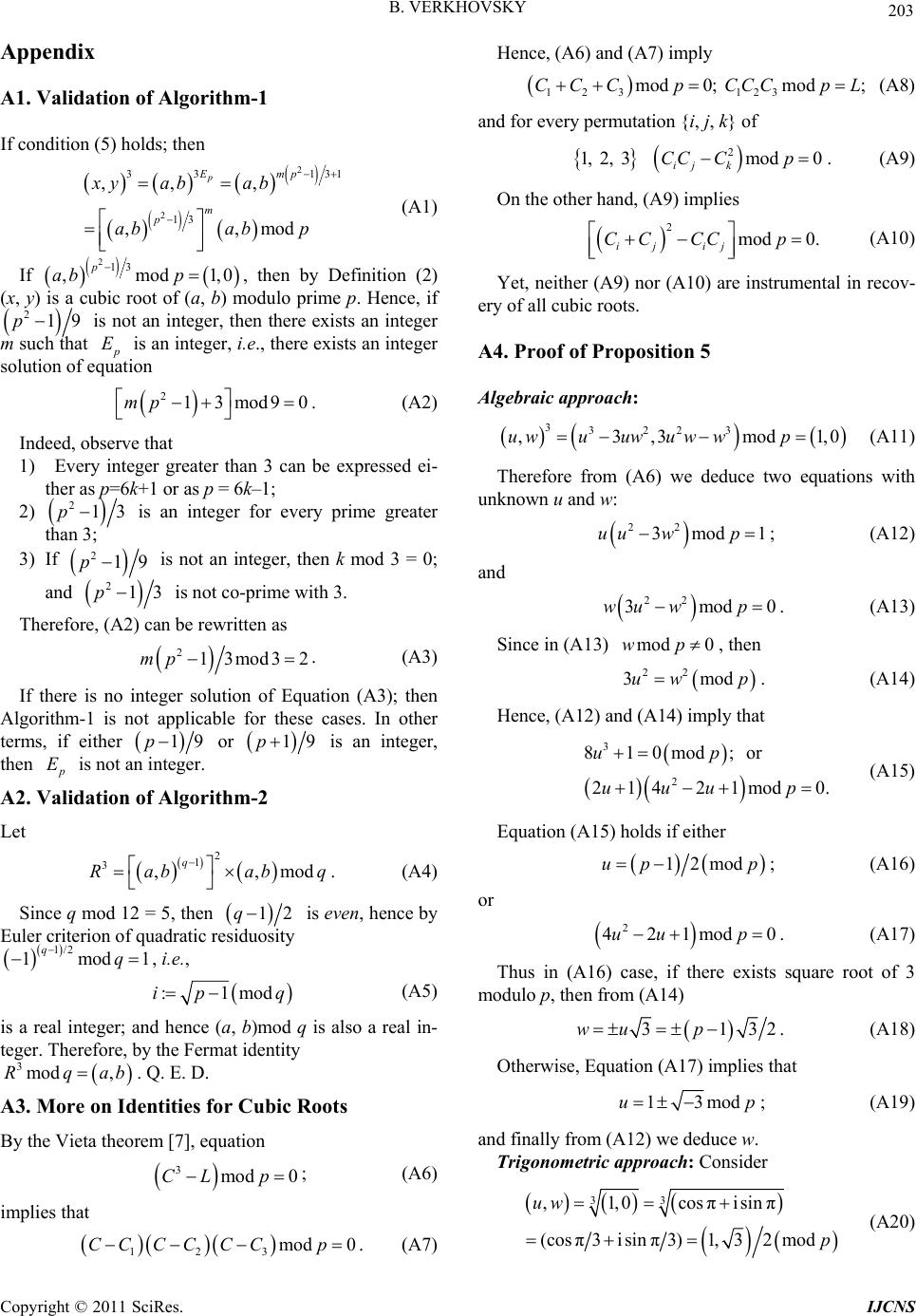 B. VERKHOVSKY Copyright © 2011 SciRes. IJCNS 203 Appendix A1. Validation of Algorithm-1 If condition (5) holds; then 2 2 131 13 33 ,, m , ,od, pmp m p E xy ab p ab ab ab (A1) If 213 ,mod1 p ab p ,0, then by Definition (2) (x, y) is a cubic root of (a, b) modulo prime p. Hence, if 219p is not an integer, then there exists an integer m such that E is an integer, i.e., there exists an integer solution of equation 213mod90mp . (A2) Indeed, observe that 1) Every integer greater than 3 can be expressed ei- ther as p=6k+1 or as p = 6k–1; 2) 213p is an integer for every prime greater than 3; 3) If 219p is not an integer, then k mod 3 = 0; and 213p is not co-prime with 3. Therefore, (A2) can be rewritten as 213mod3 2mp . (A3) If there is no integer solution of Equation (A3); then Algorithm-1 is not applicable for these cases. In other terms, if either 19p or 19p is an integer, then E is not an integer. A2. Validation of Algorithm-2 Let 2 1 3,,m q Rabab odq . (A4) Since q mod 12 = 5, then 12q is even, hence by Euler criterion of quadratic residuosity , i.e., 1/2 1mod qq 1 :1modip q (A5) is a real integer; and hence (a, b)mod q is also a real in- teger. Therefore, by the Fermat identity . Q. E. D. 3mod ,Rqa b A3. More on Identities for Cubic Roots By the Vieta theorem [7], equation 3mod 0CL p; (A6) implies that 123 mod 0CC CCCCp . (A7) Hence, (A6) and (A7) imply 123 123 mod0; mod;CCCpCCCpL (A8) and for every permutation {i, j, k} of 1, 2, 3 2mod 0 ij k CC Cp. (A9) On the other hand, (A9) implies 2mod 0. ij ij CC CCp (A10) Yet, neither (A9) nor (A10) are instrumental in recov- ery of all cubic roots. A4. Proof of Proposition 5 Algebraic approach: 33223 ,3,3moduwuuwuw wp1,0 (A11) Therefore from (A6) we deduce two equations with unknown u and w: 22 3moduuwp1 ; (A12) and 22 3modwu wp0 . (A13) Since in (A13) mod 0wp , then 22 3moduw p . (A14) Hence, (A12) and (A14) imply that 3 2 810mod; or 214 21mod 0 up uuu p . (A15) Equation (A15) holds if either 12modup p ; (A16) or 2 421moduu p0 . (A17) Thus in (A16) case, if there exists square root of 3 modulo p, then from (A14) 31wu p 32. (A18) Otherwise, Equation (A17) implies that 13modu p; (A19) and finally from (A12) we deduce w. Trigonometric approach: Consider 33 ,1,0cosπisinπ (cos π3isinπ3)1,32 mod uw p (A20) 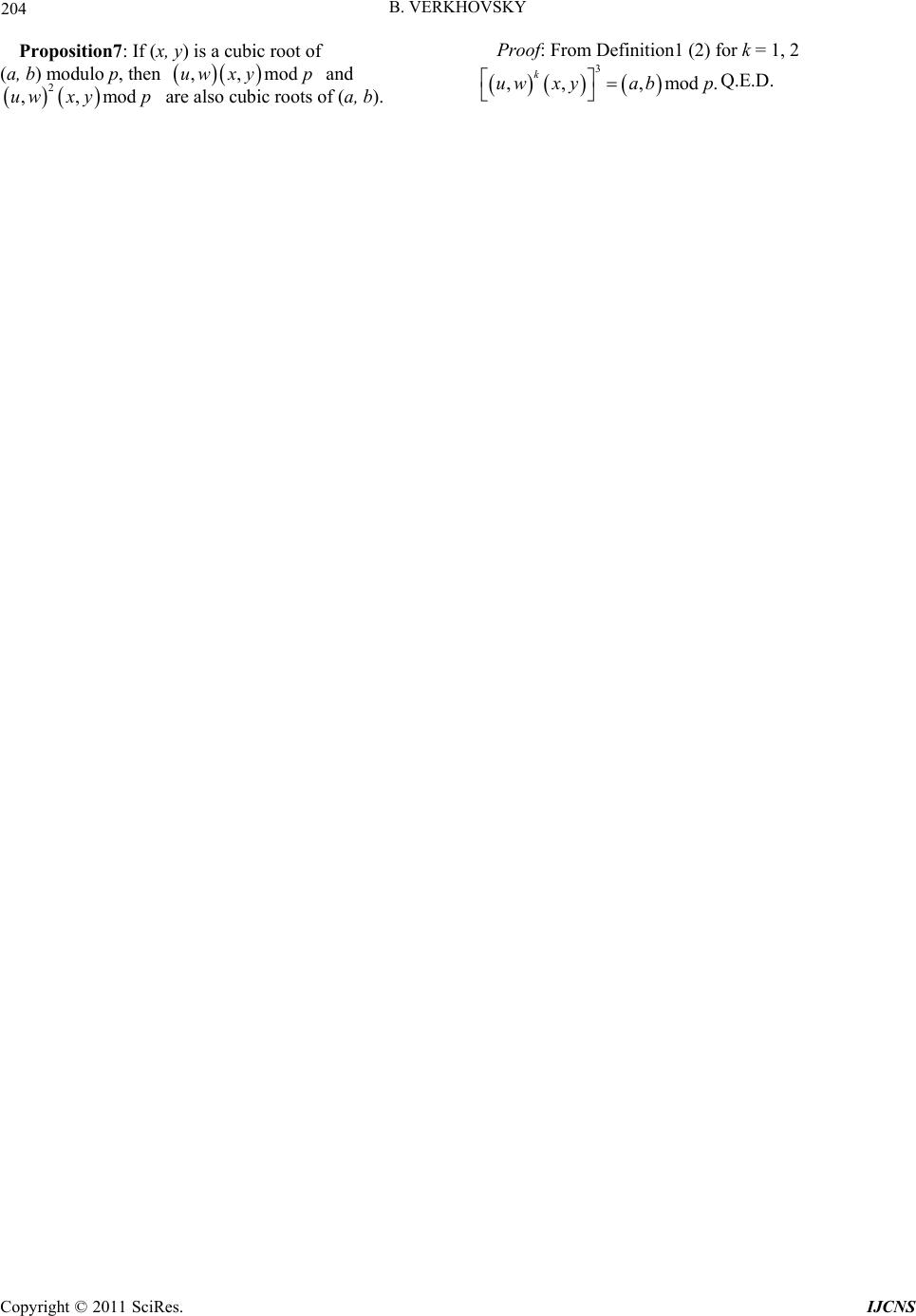 B. VERKHOVSKY 204 . Proposition7: If (x, y) is a cubic root of (a, b) modulo p, then and ,,moduwxyp 2 ,,moduw xyp are also cubic roots of (a, b). Proof: From Definition1 (2) for k = 1, 2 3 ,, ,mod k uw xyabp Q.E.D. Copyright © 2011 SciRes. IJCNS
|